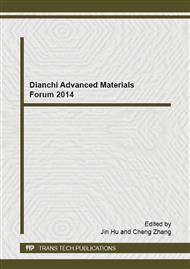[1]
Yin Weijun, R.A. Lupton, Failure mechanism of winding in-sulations in inverter-fed motors, IEEE Trans. on Elec-trical Insulation Magzine. 163 (2000) 51-59.
DOI: 10.1109/57.637150
Google Scholar
[2]
Kong F Z, Yin W Y, Mao J F, Electro-thermo-mechanical Characterizations of Various Wire Bonding Interconnects Illuminated by an Electromagnetic Pulse, IEEE Transactions on Advanced Packing. 2010, 33(3): 729-737.
DOI: 10.1109/tadvp.2010.2048902
Google Scholar
[3]
Fabiani D, Montanari G C, Contin A, E Aging acceleration of insulating materials for electrical machine windings supplied by PWM in the presence and inthe absence of partial discharges, IEEE ICSD, Eindhoven, The Netherlands. 2001, 283-286.
DOI: 10.1109/icsd.2001.955625
Google Scholar
[4]
Di Y J, Jiang J J, Bie S W, Length Effect on the Magnetostaic Properties of Arrays of Glass-Coated Amorphous Alloy Microwires, Journal of Magnetism and Magnetic Materials. 2008, 320(3/4): 537-539.
DOI: 10.1016/j.jmmm.2007.07.015
Google Scholar
[5]
Y. Matsuda,Y. Maeda, H, T. Furukawa, Sumitomo Electric Technical review, Journal of Magnetism and Magnetic Materials. No6(1975), P. 78.
Google Scholar
[6]
Kauf Hold M, Electrical stress and failure mechanism of the winding insulation in PWM-inverter-fed low-voltage induction motors, IEEE Trans. on Industrial Electronics. 2000, 47(2): 396-402.
DOI: 10.1109/41.836355
Google Scholar
[7]
Maskazu Mesaki. Hideki Goda, Hybrid composites of polyamide-Imide and silica Applied to wire insulation, Polymer journal, p.107, vol24, (1992).
DOI: 10.1109/eeic.2001.965580
Google Scholar
[8]
S. Jumonji,J. Senoo.K. Ueda,S. Chabota,S. Amano, Super Heat Resistant Ceramic Insulated Wire. Advanced in cryogenic Engineering, pp.233-237, (1997).
DOI: 10.1109/eeic.1995.482493
Google Scholar
[9]
Chung Hyunsoo, Lee Jonghwae, Jang Won bong, Thermal Properties of Polyimide Thin Films Depending on Different Curing Process. Journal of Polymer Science Part B : Polymer Physics, 2000, 38: 2879-2890.
DOI: 10.1002/1099-0488(20001115)38:22<2879::aid-polb30>3.0.co;2-a
Google Scholar
[10]
Erdal Celik, Ibrabin H. Mutlu and Yusuf S. Hascieek, Electrical properties of High Temperature Insulation Coating by the Sol-Gel Method for magnet Technolgy. Journal of Polymer Science Part B : Polymer Physics IEEE Transactions on Applied Superconductivity, 10, No, 1, (2000).
DOI: 10.1109/77.828484
Google Scholar
[11]
Gropyanovvm, Refractory metal diboride articles by cold pressing and sintering , Refractories and Industrial Ceramics , 1969, 10(12): 769-775.
Google Scholar


